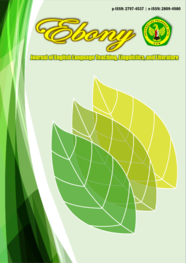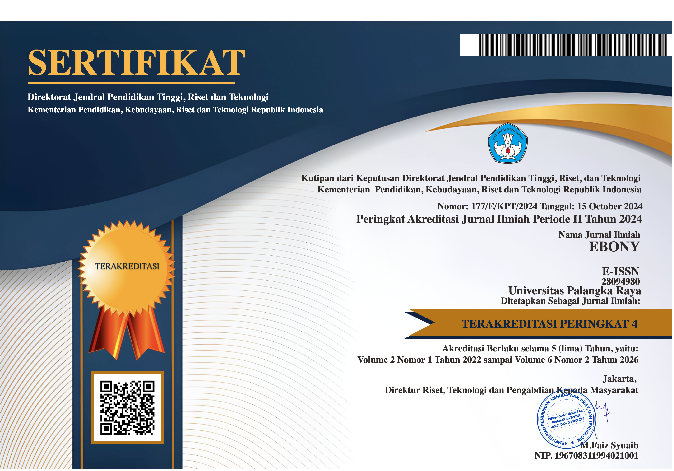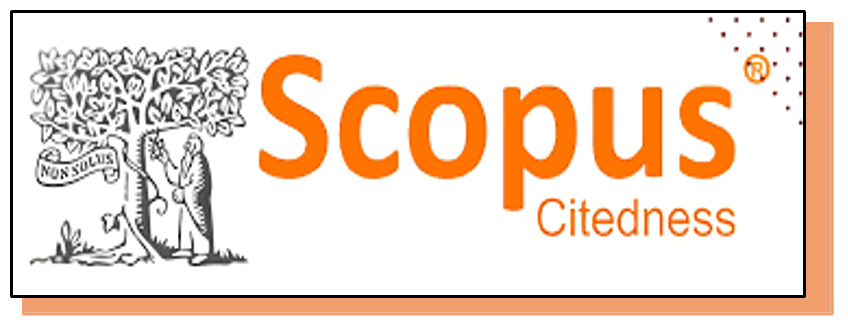Poetic Devices and Cultural Representation in Lazarus' The New Colossus
DOI:
https://doi.org/10.37304/ebony.v5i2.20093Keywords:
cultural representation, poetic devices, semiotics, The New ColossusAbstract
The New Colossus by Emma Lazarus is a well-known poem that expresses ideas of immigration, freedom, and national identity. This study aims to analyze the poem through two perspectives, namely poetic structure and cultural meaning. It focuses on how poetic devices such as metaphor, imagery, symbolism, alliteration and personification contribute to shaping the poem’s message. Using a qualitative method, the research applied Kemple's (2019) semiotic theory to interpret poetic devices as symbolic signs, while Hall's (2013) theory of representation was used to examine how the poem reflects and responds to changing social contexts. The analysis reveals that these poetic elements build a persuasive and emotional message that supports the poem’s theme of inclusivity and hope. It also shows that the meaning of the poem has shifted over time, especially in relation to modern immigration debates. This research highlights the poem’s dual role as a literary text and a cultural artefact. The findings suggest that poetic language can carry lasting social influence and that literature remains a relevant tool in understanding national identity.
Downloads
References
Anggiamurni, A. N. (2020). An Analysis of Figurative Language in Poetry by Maya Angelou. PANYONARA: Journal of English Education, 2(2), 149-160. https://doi.org/10.19105/panyonara.v2i2.3669
Aprilia, A., & Amalia, N. S. (2024). Figurative Language Analysis in Emily Dickinson’s Poem “Hope Is The Thing With Feathers.” ASPIRASI: Publikasi Hasil Pengabdian dan Kegiatan Masyarakat, 2(6), 201–206. https://doi.org/10.61132/aspirasi.v2i6.1176
Arcilla Jr., F. E. (2024). Poetic Devices, Thematic Significance, and Social Realities in Poetry: A Critical Literature Review. Randwick International of Education and Linguistics Science Journal, 5(1), 70–85. https://doi.org/10.47175/rielsj.v5i1.935
Chiranjeevi, M. (2023). Exploring the Multifaceted Themes of Identity and Belonging in Contemporary English Literature. International Journal of Creative Research Thoughts, 11(6), 583–593. https://ijcrt.org/papers/IJCRT2306519.pdf
Elaref, A. I. A., & Ahmed, S. H. A. (2024). Probing the Complexities of Cultural Identity in Langston Hughes’ Poetry: A Critical Discourse Analysis. Forum for Linguistic Studies, 6(6), 347–360. https://doi.org/10.30564/fls.v6i6.7138
Fakot, M., & Sudrajat, R. T. (2021). An Analysis of Anthology Poetry Structure of Netra Cinta By Selawitri. JLER (Journal of Language Education Research), 4(3), 128–138. https://doi.org/10.22460/jler.v4i3.6581
Gasparraj, D. C. (2025). Resistance and Rebellion in Claude McKay’s If We Must Die and To The White Fiends. BODHI International Journal of Research in Humanities, Arts and Science, 9(2), 163–169. https://www.bodhijournals.com/pdf/V9N2/Bodhi_V9N2_025.pdf
Hall, S., Evans, J., & Nixon, S. (Eds.). (2013). Representation: Cultural Representations and Signifying Practices (2nd ed.). SAGE Publications.
Johnson-Laird, P. N., & Oatley, K. (2022). How Poetry Evokes Emotions. Acta Psychologica, 224(2), 1–12. https://doi.org/10.1016/j.actpsy.2022.103506
Kemple, B. (2019). The Intersection of Semiotics and Phenomenology: Peirce and Heidegger in Dialogue. De Gruyter Mouton. https://doi.org/10.1515/9781501505171
Lazarus, E. (1883). The New Colossus. Poetry Foundation. Retrieved March 30, 2025, from https://www.poetryfoundation.org/poems/46550/the-new-colossus
Malik, A., Malik, A., & Waheed, M. (2025). Exploring Marginalization and Social Injustice: A Critical Discourse Analysis of William Blake’s “The Chimney Sweeper.” Review of Education, Administration and Law (REAL), 8(1), 87–97. https://doi.org/10.47067/real.v8i1.408
Milevski, U., & Wetenkamp, L. (2022). Introduction: Relations between Literary Theory and Memory Studies. Journal of Literary Theory, 16(2), 197–212. https://doi.org/10.1515/jlt-2022-2022
Mishra, S., Joshi, P. U., & Gardner, C. (2024). Exploring The Intersection of Marginalized Voices and Contemporary Literary Trends. ShodhKosh: Journal of Visual and Performing Arts, 5(5), 1209–1215. https://www.granthaalayahpublication.org/Arts-Journal/ShodhKosh/article/view/2929
Mulyati, S. (2019). The Analysis of Five William Blake’s Poems. Wanastra: Jurnal Bahasa dan Sastra, 11(2), 113–120. https://doi.org/10.31294/w.v11i2.5414
Nindyasmara, K. R. (2019). Negotiation of Identity in Diasporic Literature: A Case Study on Amy Tan’s The Hundred Secret Senses and Leslie Marmon Silko’s Ceremony. Rubikon : Journal of Transnational American Studies, 3(1), 54-65. https://doi.org/10.22146/rubikon.v3i1.47838
Phillips, N., & Khoja, S. (2025). The New, New Colossus: An Annotated Version of “The New Colossus” by Emma Lazarus. City University of New York Law Review, 28(1), 1–7. https://academicworks.cuny.edu/clr/vol28/iss1/7/
Pillay, D., Pithouse-Morgan, K., & Naicker, I. (2024). Different Together: A Poetic Reading of Arts-Inspired Creations as Embodied Explorations of Social Cohesion. Qualitative Inquiry, 30(2), 204–211. https://doi.org/10.1177/10778004231176099
Said, R. (2023). An Analysis of Figurative Language in The Poem The Phoenix and The Turtle by William Shakespeare. JUPE: Jurnal Pendidikan Mandala, 8(3), 883-887. https://doi.org/10.58258/jupe.v8i3.5841
Wolf, W. (2020). Lyric Poetry and Narrativity: A Critical Evaluation, and the Need for “Lyrology.” Narrative, 28(2), 143–173. https://doi.org/10.1353/NAR.2020.0008
Ziadi, A. (2025). The Aesthetic Judgements of Metaphors in Understanding Literary Texts. Humanities and Social Sciences Communications, 12(1), 1–11. https://doi.org/10.1057/s41599-025-04523-6
Downloads
Published
How to Cite
Issue
Section
License
Copyright (c) 2025 Dewa Ayu Febry Hendrayani, Luh Putu Laksminy, I Gusti Ayu Mahatma Agung

This work is licensed under a Creative Commons Attribution 4.0 International License.











